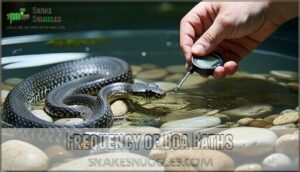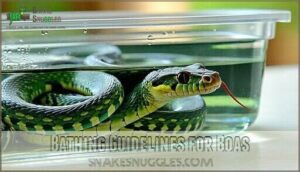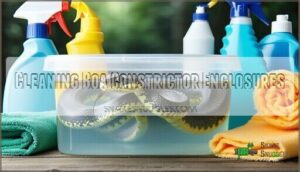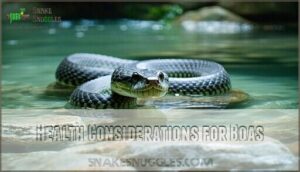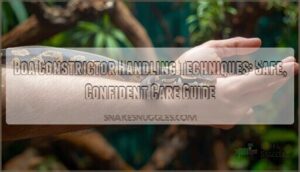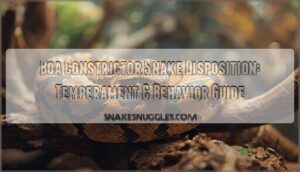This site is supported by our readers. We may earn a commission, at no cost to you, if you purchase through links.
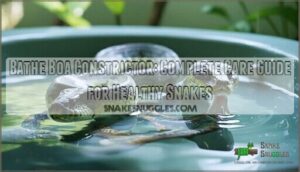
The water should feel like a warm bath to your wrist, around 80-85°F. Let your boa soak for 15-30 minutes maximum.
Most boas actually bathe themselves in their water dishes, especially before shedding when they’re feeling itchy. Never force a reluctant snake into water, and always supervise the process.
Your boa will often drink while soaking, killing two birds with one stone. Proper bathing technique involves more nuanced timing considerations.
Table Of Contents
- Key Takeaways
- Bathing Boa Constrictors
- Frequency of Boa Baths
- Bathing Guidelines for Boas
- Boa Constrictor Bathing Process
- Shedding and Boa Baths
- Using Soaking Bowls for Boas
- Cleaning Boa Constrictor Enclosures
- Health Considerations for Boas
- Frequently Asked Questions (FAQs)
- How do you give a boa constrictor a bath?
- How often should I bathe my boa?
- Is it OK to give a snake a bath?
- Do boa constrictors like to soak?
- Can boa constrictors swim in deep water?
- How do I handle a wet boa?
- Why does my boa soak excessively?
- Is it safe to bathe sick boas?
- How to reduce stress during a boa bath?
- Can baby boas drown during bathing?
- Conclusion
Key Takeaways
- You should bathe your boa constrictor in shallow, lukewarm water (80-85°F) for 15-30 minutes maximum, filling the container only halfway up your snake’s body to prevent drowning while allowing comfortable soaking.
- You’ll only need to bathe your boa 1-2 times per month under normal conditions, increasing frequency during shedding cycles when their skin appears dull or eyes turn cloudy blue.
- You must supervise your boa constantly during bathing sessions, never leaving them unattended, and watch for stress signals like rapid movement or escape attempts that indicate they’re uncomfortable.
- You shouldn’t use any soaps or chemicals during bathing – stick to clean, dechlorinated water and gently pat your boa dry with a soft towel afterward rather than rubbing vigorously.
Bathing Boa Constrictors
Bathing boa constrictors isn’t rocket science, but it requires careful attention to Bath Safety and proper Handling Techniques.
Your snake benefits from regular reptile bathing sessions that promote Stress Reduction and overall health. Start with chemical-free Water Quality – think drinking water standards for your scaly friend.
Your boa deserves spa-day treatment with pristine water and gentle care—no chemicals, just pure relaxation.
The Bath Benefits include improved hydration, easier shedding, and cleanliness. Snake bathing should feel natural, not forced.
Remember that boas are nocturnal hunters, so they might be more receptive to bathing in the evening, and their average length is 5-8 feet.
Watch your boa’s body language during bathing sessions to make certain they’re comfortable and relaxed throughout the process.
Frequency of Boa Baths
Unlike humans who need daily hygiene routines, your boa constrictor’s bathing frequency follows a completely different rhythm.
Most healthy boas require baths only 1-2 times per month maximum. Over-bathing risks stripping your snake’s natural protective oils, potentially causing skin problems.
Your bathing schedule should consider several key factors:
- Age considerations – juveniles need less frequent baths than adults
- Seasonal adjustments – increase frequency during dry winter months
- Shedding cycles – bath when you notice cloudy eyes or dull skin
- Individual needs – some boas naturally soak more in their water dishes
- Health monitoring – watch for excessive soaking, which may indicate mites
To guarantee safety, the water temperature should be within the safe temperature range.
Remember, boa constrictor care means respecting their natural behaviors. They’re not dirty creatures requiring frequent scrubbing!
Bathing Guidelines for Boas
Understanding proper frequency sets you up for success, but following specific bathing guidelines guarantees your boa constrictor stays healthy and stress-free during each session.
Start with a large, shallow container that gives your snake room to move comfortably. Think of it like choosing a bathtub over a coffee cup – space matters. Water depth should reach halfway up your boa’s body, allowing easy breathing while providing full benefits.
Safe temperatures range between 80-85°F, matching your snake’s enclosure warmth. Test with your elbow like you’d for a baby’s bath. Bath duration shouldn’t exceed 15 minutes to prevent stress or overheating.
Skip soaps and chemicals entirely – they’ll irritate sensitive snake skin. Focus on stress reduction by moving slowly and speaking softly. Your boa might seem nervous initially, but gentle handling builds trust.
After bathing, use proper drying methods with a soft towel, patting gently rather than rubbing. Remember that boas are ectothermic, so maintaining proper temperature control is essential for their health. These snake bathing tips create positive experiences for both you and your reptile companion.
Boa Constrictor Bathing Process
Getting your hands wet is easier than you think. The boa constrictor bathing process requires patience and the right setup.
Start by filling a shallow container with lukewarm water – think baby bath temperature, not hot tub heat. Water Temperature should feel neutral to your skin, around 80-85°F. Your snake’s body should be halfway submerged, never fully underwater.
Here’s your snake bathing process checklist:
- Support your boa’s body weight when placing it in water
- Keep Bath Duration between 10-15 minutes maximum
- Never leave your snake unattended during soaking
Watch for stress signals like rapid movement or attempts to escape. Safe Handling means moving slowly and supporting the snake’s weight throughout the process. Many owners find a suitable boa soaking bowl makes the process easier.
After soaking, lift your boa onto a clean, soft towel. Drying Methods involve gentle patting, not rubbing. The Bath Benefits include improved hydration and easier shedding. This snake bathing routine strengthens your bond while promoting health.
Shedding and Boa Baths
Your boa’s shedding signs appear when skin turns dull and eyes cloud blue.
Bath benefits include softening old skin for easier removal. Create lukewarm baths during this phase, but don’t force stuck shed pieces off manually.
A boa’s enclosure should have rough surfaces available to aid in the shedding process. Bath additives like shedding aids help, though use sparingly since snake shedding happens naturally.
Post-shedding examination confirms complete skin removal, especially around eyes and tail tips.
| Shedding Phase | Bath Frequency |
|---|---|
| Pre-shed (dull skin) | Every 2-3 days |
| Blue phase (cloudy eyes) | Daily if needed |
| Active shedding | As required |
| Post-shed | Once for inspection |
| Normal periods | Weekly |
Using Soaking Bowls for Boas
Your boa constrictor needs a proper soaking bowl setup for ideal hydration and humidity control. Think of it as their personal spa – it’s where they’ll relax and regulate their body temperature.
Here’s what you need to know:
- Bowl Size: Choose a container that accommodates your boa’s full body length comfortably
- Water Depth: Keep it shallow enough to prevent drowning while allowing full submersion
- Bowl Material: Select heavy-bottomed, stable materials that won’t tip over during use
Place the soaking bowl away from direct heat sources but within easy access. A proper setup requires a durable soaking container for your pet.
Clean weekly with reptile-safe products and replace water daily for proper bathing conditions.
Cleaning Boa Constrictor Enclosures
Keeping your boa’s home clean isn’t just about appearances—it’s essential for preventing bacterial growth and maintaining your snake’s health.
You’ll need to establish a routine that includes daily spot cleaning, weekly disinfection, and monthly deep cleans to create the safest environment for your scaly friend, which is crucial for your snake’s overall health.
Daily Cleaning
Your soaking bowl setup works perfectly when paired with consistent daily cleaning habits.
Remove all waste immediately – droppings, shed skin, and leftover prey create breeding grounds for harmful bacteria. Spot cleaning prevents odors and maintains snake hygiene.
You can simplify the cleaning process using a snake waste remover.
| Daily Task | Why It Matters |
|---|---|
| Water freshness check | Prevents pathogen control issues |
| Waste removal | Stops bacterial growth cold |
| Dish hygiene maintenance | Keeps your boa healthy |
This routine takes five minutes but saves hours of deep cleaning later.
Weekly Cleaning
Daily spot cleaning sets the stage, but weekly cleaning takes your boa constrictor’s hygiene to the next level. This deeper maintenance routine keeps your snake healthy and your enclosure pristine.
Start by disinfecting surfaces with reptile-safe cleaner throughout the habitat. Replace all water completely, even if it looks clean. Check temperature and humidity levels to confirm they’re within proper ranges for your boa’s comfort.
Weekly cleaning essentials include:
- Remove any missed waste or shed skin pieces
- Scrub water bowls with diluted vinegar solution
- Wipe down glass walls and decorations thoroughly
- Test heating elements and thermostats for accuracy
- Inspect substrate for mold or bacterial growth
Monthly Cleaning
Once a month, you’ll need to roll up your sleeves for deep cleaning your boa constrictor’s home.
Remove everything from the enclosure and perform complete equipment sterilization using reptile-safe disinfectants.
Substrate replacement is mandatory—toss the old bedding and add fresh material.
Sanitizing enclosure surfaces eliminates hidden bacteria and supports mold prevention.
This thorough monthly cleaning maintains ideal health conditions.
Think of it as spring cleaning, but for your snake’s apartment—they’ll appreciate the fresh start!
Health Considerations for Boas
You’ll need to watch for specific signs that indicate your boa’s health status, as changes in bathing behavior often signal underlying issues like mites, stress, or shedding problems.
Understanding these health indicators helps you provide proper care and know when it’s time to consult a reptile veterinarian for professional guidance on issues like stress.
Proper Bathing Techniques
After maintaining a spotless enclosure, you’ll want to master proper bathing techniques for your boa constrictor. Getting this right means healthier shedding and happier snakes.
Safe handling during snake bathing requires attention to these key factors:
- Water depth should reach only halfway up your boa’s body
- Temperature control between 80-85°F prevents shock or stress
- Bath duration shouldn’t exceed 30 minutes with constant supervision
- Use lukewarm, chemical-free water in dedicated bathing containers
- Drying methods involve gentle toweling before returning to enclosure
Shedding Support Methods
Warm baths work wonders for boa constrictor shedding, but never force off snake skin.
Your boa’s natural process needs gentle support, not aggressive intervention.
Essential shedding support strategies:
- Maintain proper humidity control at 60-70% during shedding cycles
- Use commercial shedding aids sparingly in lukewarm bathwater
- Apply gentle handling techniques to avoid damaging delicate new skin
- Provide rough surfaces like branches for natural rubbing assistance
- Schedule veterinary checkups if shedding problems persist beyond normal cycles
Hydration and Humidity
Proper hydration keeps your boa constrictor healthy and prevents shedding problems.
Water quality matters—use dechlorinated water in clean bowls.
Enclosure misting helps maintain ideal humidity levels between 60-70%.
Your snake’s bathing habits reveal hydration needs.
| Humidity Zone | Temperature Range | Monitoring Method |
|---|---|---|
| Cool Side | 75-80°F | Digital hygrometer |
| Warm Side | 80-85°F | Infrared thermometer |
| Overall Tank | 60-70% humidity | Weekly water changes |
| Shedding Period | 70-80% humidity | Misting bottle setup |
Frequently Asked Questions (FAQs)
How do you give a boa constrictor a bath?
Like Cleopatra’s legendary milk baths, your boa deserves royal treatment.
Fill a shallow container with lukewarm water (80-85°F), ensuring it’s halfway up your snake’s body.
Supervise constantly and limit soaking to thirty minutes maximum.
How often should I bathe my boa?
Most boas don’t need regular baths – only bathe yours every few weeks or when they’re shedding.
If they’re soaking constantly in their water dish, something’s wrong with temperature or humidity.
Is it OK to give a snake a bath?
Don’t bite off more than you can chew—yes, you can safely bathe your snake.
Use lukewarm water, supervise constantly, and keep sessions under thirty minutes.
It’s perfectly natural and beneficial for their health.
Do boa constrictors like to soak?
Yes, boa constrictors enjoy soaking in their water dishes regularly.
They’ll soak to stay hydrated, cool down, and ease shedding.
You’ll often find your boa taking leisurely soaks, especially during warmer weather.
Can boa constrictors swim in deep water?
Despite reaching 13 feet in length, boa constrictors aren’t natural swimmers.
You shouldn’t let your boa swim in deep water—they’ll struggle and could drown.
Stick to shallow soaking where they can easily lift their heads above water to avoid any potential drowning.
How do I handle a wet boa?
Gently towel-dry your boa with soft, clean fabric after bathing.
Support its body while patting moisture away—don’t rub vigorously.
Make certain it’s completely dry before returning to its enclosure to prevent bacterial growth.
Why does my boa soak excessively?
Something’s up when your boa turns into a permanent pool lounger.
Check for mites, improper temperatures, or low humidity.
Excessive soaking often signals stress, health issues, or inadequate hiding spots in their enclosure.
Is it safe to bathe sick boas?
Bathing sick boas requires extra caution and veterinary guidance.
You’ll need to monitor water temperature closely, limit soaking time, and watch for stress signs.
Don’t bathe severely ill snakes without professional advice first, as this requires careful consideration of the snake’s health.
How to reduce stress during a boa bath?
Keep water temperature between 80-85°F and limit bath time to 15-20 minutes.
Support your boa’s body gently, move slowly, and watch for signs of distress.
Let them acclimate gradually to reduce anxiety.
Can baby boas drown during bathing?
Young boa constrictors face higher drowning risks than adults due to their smaller size.
You’ll need water levels halfway up their body, constant supervision, and shallow containers.
Never leave baby boas unattended during baths.
Conclusion
Remember, you can’t teach an old dog new tricks, but you can definitely learn to bathe boa constrictor properly with practice.
You’ve now got all the tools needed for successful snake bathing – from timing and temperature to recognizing when your boa needs extra help during shedding.
Regular baths support your snake’s health, aid natural shedding, and provide essential hydration.
Follow these guidelines consistently, and you’ll maintain a happy, healthy boa constrictor for years to come.
- https://www.thesprucepets.com/best-reptile-water-dishes-4842385
- https://www.itis.gov/servlet/SingleRpt/SingleRpt?search_topic=TSN&search_value=174321
- http://www.humanesociety.org/assets/pdfs/wildlife/captive/captive-constrictor-snake-incidents.pdf
- http://www.bioone.org/doi/abs/10.1670/45-04N
- https://oddlycutepets.com/bathe-boa-constrictor/

